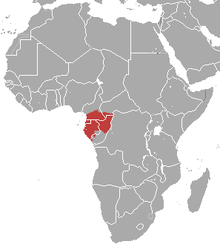Golden angwantibo
| Golden angwantibo[1] | |
|---|---|
| Conservation status | |
| Scientific classification | |
| Kingdom: | Animalia |
| Phylum: | Chordata |
| Class: | Mammalia |
| Order: | Primates |
| Family: | Lorisidae |
| Genus: | Arctocebus |
| Species: | A. aureus |
| Binomial name | |
| Arctocebus aureus de Winton, 1902 | |
 | |
| Golden angwantibo range | |
| Synonyms | |
| |
The golden angwantibo (Arctocebus aureus) is a strepsirrhine primate from the family Lorisidae. It shares the Arctocebus genus with the Calabar angwantibo (Arctocebus calabarensis) and together they are commonly called the golden pottos. The golden angwantibo is found in Cameroon, the Republic of Congo, Equatorial Guinea and Gabon. Its usual habitat is rain forest, but it has also been known to live on farmland.
Like the Calabar angwantibo, the golden angwantibo weighs between 266 and 465 grams and has a stumpy tail, abbreviated index fingers, a specialised grooming claw on each foot and a white line on its face. It can be distinguished from its cousin largely by its colour. The fur on its back is red-gold, with a more muted red on its belly. Unlike the Calabar angwantibo, the golden angwantibo has no nictitating membrane.
The golden angwantibo is a nocturnal and arboreal species that is typically found on small branches 5-15 metres above ground. Its diet consists of around 85% insects (especially caterpillars) and 14% fruit. Its foraging, antipredator, social and reproductive behaviour are extremely similar to those of the Calabar angwantibo.
References
- ↑ Groves, C. P. (2005). Wilson, D. E.; Reeder, D. M, eds. Mammal Species of the World (3rd ed.). Baltimore: Johns Hopkins University Press. p. 122. OCLC 62265494. ISBN 0-801-88221-4.
- ↑ Bearder, S., Oates, J. F. & Groves, C. P. (2008). Arctocebus aureus. In: IUCN 2008. IUCN Red List of Threatened Species. Retrieved 1 January 2009.
External links
| Wikispecies has information related to: Golden Angwantibo |
- Golden potto (Arctocebus aureus) at The Primata
| |||||||||||||||||||||||||||
